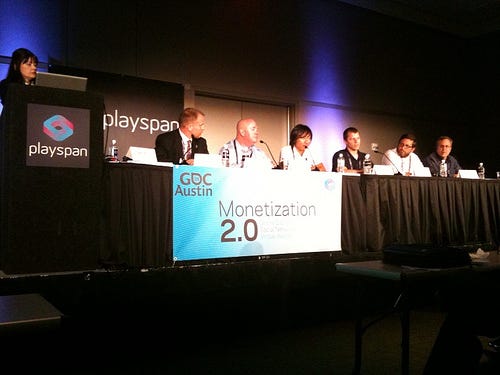An MMOs and Virtual Worlds Panel at PlaySpan’s Monetization 2.0 Forum had some great data points. I did some scribbling and typed up my notes below so forgive any inaccuracies.

The panel was moderated by EA’s Nanea Reeves with panelists:
- Jim Crowley l CEO, Turbine
- Cary Rosenzweig l CEO, IMVU
- Johny Mang l EA- Dice
- Tom Hale | Chief Product Officer, Linden Labs/ Second Life
- John Bates | Entropia
- Joshua Hong | K2 Network
Linden
- Second Life makes close to $100 million and not less than $80 million. They make money in three ways: 1) sale of currency, 2) premium subscription and 3) a hosting model where users pay them to allow their 3D objects to persist
- Linden tracks engagement (user hours), transaction value, % paying, repeat usage, $50 MM user value is exchanged each month.
- More focused on retention instead of acquisition, looking at users over 2 year lifetimes.
- Fraud is definitely an issue especially when $$ can come out of the system. Just a cost of doing business.
- Top merchant at Second Life is making $1 million/year selling sweaters/skirts
IMVU
- 80% of revenues are from consumers (micro-transactions and user-generated content) and 20% from advertising
- The essence of monetization is building a service that customers will pay for. You have to be massive to be viable with an advertising model.
- In Asia (in general, not IMVU) 5–10% range of free to paid conversion % is the common stat
- Free users add value to the paid users, larger and engaging community
- IMVU is like Ebay, with 2.5 million items and 20,000 developers creating them. Entrepreneurs creating and selling for others and IMVU is the neutral party since they aren’t creating the goods directly
- Top 10 creators on IMVU each made over $100k annual revenue
- Paid items are long tail, top 10 items are only = 0.2% of sales. Users want to be different.
Turbine
- Turbine recently transferred from subscription to a hybrid subscription & micro-transactions model. Hybrid model offers greater flexibility and choice.
- Subscription only models leave out the audience that are willing to pay less and don’t capture those that are willing to pay more, so they’ve moved to optional subscription.
- Since announcing their service they’ve actually seen subscriptions go up and concurrency rates rise too.
K2
- 100% of K2 revenues are from item sales
- MMOs: “ARPU is high, relationships is long and persistence is everything”
- K2’s focus is being very involved with community management
- Item sales mean that countries such as Turkey, Brazil, the Eastern bloc are full of opportunities for free to play.
- Free to play is nothing but a pricing option
- K2 uses traditional resellers of prepaid card codes to reach emerging markets like Turkey, China, Eastern Europe
EA
- Battlefield: Heroes sells mostly decorative items but launched Boost packs and this item immediately went to the top of the list
- They also have a RTS with boost items and found conversion rates are much higher
- Items that have usefulness in the game tend to convert better
- EA is targeting a 7–8% conversion rate for free to play games, but expects that to lower to 5% with social network traffic
9/18 EDIT: Added photo and Joshua Hong of K2 to the speakers list (thanks Clay!)